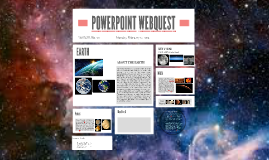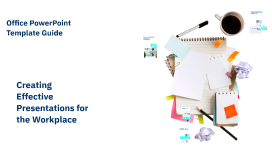POWERPOINT WEBQUEST
Transcript: The Planet Earth is 92.96 million miles from the Sun. One rotation takes 24 hours, or a day. One evolution is a year or 365 days. Some characteristics of its surface are that it's covered mostly by water. Its tectonic plates are always moving and constantly changing the surface. The earth was an atmosphere which make the earth have gravity. The earth also has some features such as living things and different land forms. The earth's atmosphere has four layers. They each get hotter the deeper it goes. The mantle is the largest one. The inner and outer core are the hottest, and the crust is the coldest and thinnest. It is not known who discovered Earth, some say it was created by gods, others say that a volcanic eruption formed it. The spacecrafts always visit earth, heck they live in it! Some unique features of Earth is that its one of the only known planets to have living things. The earth only has one moon, the distance apart is about 238,900 miles MARS From an average distance of 67 million miles (108 million kilometers), Venus is 0.7 astronomical units away from the sun. Venus takes 243 Earth days to complete a full rotation. It takes 225 Earth days to do a full revolution.Venus has mountains, valleys, and tens of thousands of volcanoes. The highest mountain on Venus, Maxwell Montes, is 20,000 feet high (8.8 kilometers), similar to the highest mountain on Earth, Mount Everest. The landscape is dusty, and surface temperatures reach a scalding 880 degrees Fahrenheit (471 degrees Celsius). Venus is covered in craters, but none are smaller than 0.9 to 1.2 miles (1.5 to 2 kilometers) across. Small meteoroids burn up in the dense atmosphere, so only large meteoroids reach the surface and create impact craters. Venus' atmosphere consists mainly of carbon dioxide, with clouds of sulfuric acid droplets. The thick atmosphere traps the sun's heat, resulting in surface temperatures higher than 880 degrees Fahrenheit (470 degrees Celsius). The atmosphere has many layers with different temperatures. At the level where the clouds are, about 30 miles up from the surface, it's about the same temperature as on the surface of the Earth. Venus has no moons. Galileo pointed his telescope at Venus in 1610, so Galileo discovered Venus. On December 15, 1970 an unmanned Soviet spacecraft, Venera 7, became the first spacecraft to land on Venus. EARTH'S MOONS Mars is about 141.6 million miles away from the Sun. It takes 24 hours, 39 minutes, and 35.244 seconds to do one full rotation, but it takes 687 days to do one full revolution. The common surface features of Mars include dark slope streaks, dust devil tracks, sand dunes, Medusae Fossae Formation, fretted terrain, layers, gullies, glaciers, scalloped topography, chaos terrain, possible ancient rivers, pedestal craters, brain terrain, and ring mold craters. The atmosphere of Mars is about 100 times thinner than Earth's, and it is 95 percent carbon dioxide. Here's a breakdown of its composition: Carbon dioxide: 95.32 percent. Nitrogen: 2.7 percent. The atmosphere of Mars is the layer of gases surrounding Mars. It also has 2 moons, the Phobos and Deimos. Because of this, we don't know who exactly discovered Mars. We do know it was named after the Roman god of war, because its reddish color reminded people of blood. In 1659, Christian Huygens discovered a strange feature on the surface of the Red Planet. It was later called the Syrtis Major. Many spacecrafts have visited mars, one of them is called MAVEN launched on 18 November 2013 to futher explore mars. Mars is also called the red planet. Venus vs. Earth Mars is smaller than Earth Mars is farther away from the sun, being the 4th planet and Earth being the 3rd Mars' surface is red and drier than Earth, Earth's surface is mostly water Mars' atmosphere consists of approximately 96% carbon dioxide, 1.9% argon, 1.9% nitrogen, and traces of free oxygen, carbon monoxide, water and methane, among other gases, for a mean molar mass of 43.34 g/mol. Mars' gravity is 3.711 m/s² Mars' Moons: Monday, February 17, 2014 Headline 5 EARTH ABOUT THE EARTH Earth only has one moon Venus is smaller than the Earth From an average distance of 67 million miles (108 million kilometers), Venus is 0.7 astronomical units away from the sun. So it's closer to the sun Venus' surface is pretty rocky and hot, unlike earth's which is mostly water Mars vs. Earth: Venus Vol XCIII, No. 311 POWERPOINT WEBQUEST

















